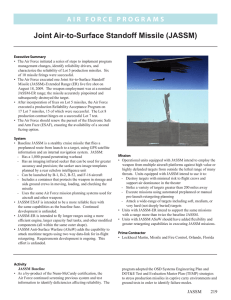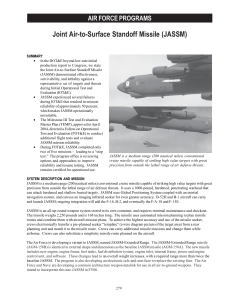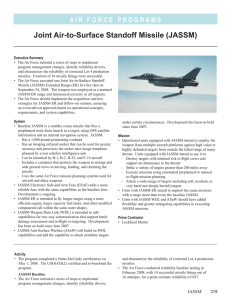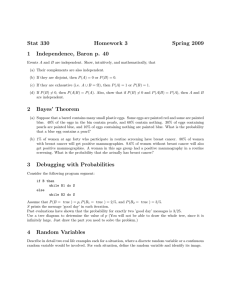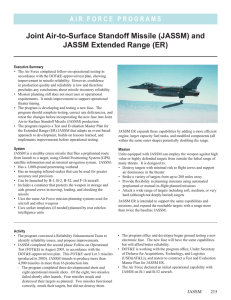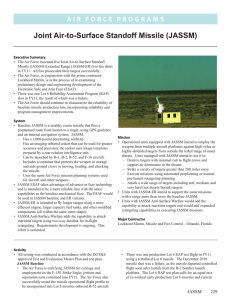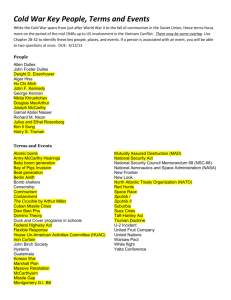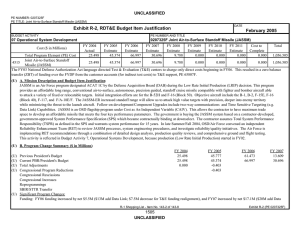T Joint Air-to-Surface Standoff Missile (JASSM) AIR FORCE PROGRAMS
advertisement
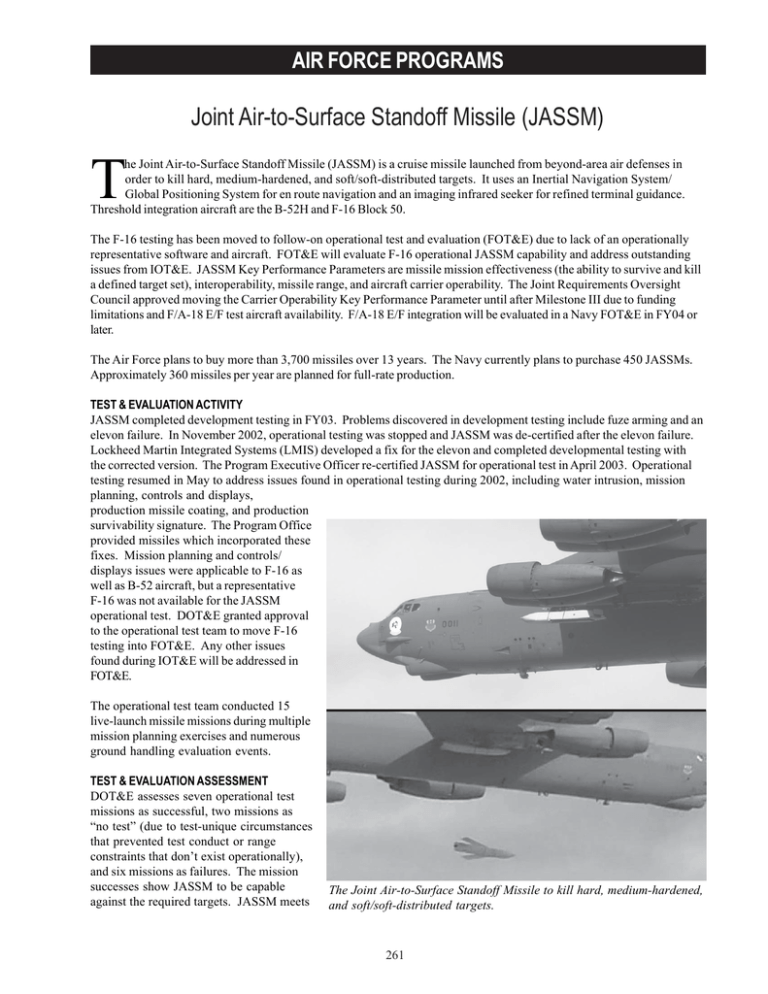
AIR FORCE PROGRAMS Joint Air-to-Surface Standoff Missile (JASSM) T he Joint Air-to-Surface Standoff Missile (JASSM) is a cruise missile launched from beyond-area air defenses in order to kill hard, medium-hardened, and soft/soft-distributed targets. It uses an Inertial Navigation System/ Global Positioning System for en route navigation and an imaging infrared seeker for refined terminal guidance. Threshold integration aircraft are the B-52H and F-16 Block 50. The F-16 testing has been moved to follow-on operational test and evaluation (FOT&E) due to lack of an operationally representative software and aircraft. FOT&E will evaluate F-16 operational JASSM capability and address outstanding issues from IOT&E. JASSM Key Performance Parameters are missile mission effectiveness (the ability to survive and kill a defined target set), interoperability, missile range, and aircraft carrier operability. The Joint Requirements Oversight Council approved moving the Carrier Operability Key Performance Parameter until after Milestone III due to funding limitations and F/A-18 E/F test aircraft availability. F/A-18 E/F integration will be evaluated in a Navy FOT&E in FY04 or later. The Air Force plans to buy more than 3,700 missiles over 13 years. The Navy currently plans to purchase 450 JASSMs. Approximately 360 missiles per year are planned for full-rate production. TEST & EVALUATION ACTIVITY JASSM completed development testing in FY03. Problems discovered in development testing include fuze arming and an elevon failure. In November 2002, operational testing was stopped and JASSM was de-certified after the elevon failure. Lockheed Martin Integrated Systems (LMIS) developed a fix for the elevon and completed developmental testing with the corrected version. The Program Executive Officer re-certified JASSM for operational test in April 2003. Operational testing resumed in May to address issues found in operational testing during 2002, including water intrusion, mission planning, controls and displays, production missile coating, and production survivability signature. The Program Office provided missiles which incorporated these fixes. Mission planning and controls/ displays issues were applicable to F-16 as well as B-52 aircraft, but a representative F-16 was not available for the JASSM operational test. DOT&E granted approval to the operational test team to move F-16 testing into FOT&E. Any other issues found during IOT&E will be addressed in FOT&E. The operational test team conducted 15 live-launch missile missions during multiple mission planning exercises and numerous ground handling evaluation events. TEST & EVALUATION ASSESSMENT DOT&E assesses seven operational test missions as successful, two missions as “no test” (due to test-unique circumstances that prevented test conduct or range constraints that don’t exist operationally), and six missions as failures. The mission successes show JASSM to be capable against the required targets. JASSM meets The Joint Air-to-Surface Standoff Missile to kill hard, medium-hardened, and soft/soft-distributed targets. 261 AIR FORCE PROGRAMS the Key Performance Parameters of range, missile mission effectiveness, and interoperability. One mission discovered a problem with missile mission data changes. The crew changed missile missions (a typical crew procedure) leading to the loss of the preplanned seeker template for that missile. The missile successfully struck the target without seeker updates. The solution to this problem will be implemented with a missile software change and tested in FOT&E. Of the six JASSM missiles with live warheads launched at realistic targets, four hit their targets. Two shots were required to kill a hardened bunker; however, a single shot killed a medium hardened bunker. The attack of a weapons bunker resulted in the failure of the warhead to detonate and no kill was achieved. There were a total of 15 live-warhead launches against realistic targets (developmental test and operational test), nine of which provided useful lethality data. Twice JASSM demonstrated it can kill a hardened bunker in just two shots and it can kill a representative mediumhardened bunker, communications van, radar, and weapons bunker with a single shot. Of the three flights in which the warhead failed to detonate (twice in FY01 against a radar and once in FY03 against a weapons bunker), the causes of failure have been identified only for the FY01 occurrences. The six failures include problems in fuzing (two failures), engine start (one failure), and B-52 carriage and interface (three failures). The fuze failures were attributed to production quality control and are being mitigated by extra steps in fuze qualification and production oversight. The engine failure was attributed to damage from a foreign object in the fuel line and is being mitigated with changed production procedures to reduce the possibility of reoccurrence. The B-52 problems were attributed to computer processor and carriage equipment problems. These are being deferred to a later date when the B-52 avionics can be updated. In the short term, they are mitigated by changes in crew procedures to try to prevent the problems from reoccurring. Reliability and maintainability testing included captive-carry, environmental, and aircraft loading evaluations on the B-52. Rainwater collected inside the protective ground covers and the missile itself, causing paint bubbling and electrical failures. The events completed after recertification show the viability of the fixes implemented to correct problems with water intrusion/retention and missile durability found during previous operational testing. These events also included testing with a re-designed missile cover. The redesigned cover does not mitigate all risks and problems found in using such a cover, but it corrects the mission-essential problems of water intrusion/retention. The Air Force intends to develop and field a JASSM-Extended Range variant to increase the missile’s standoff range. At a minimum, the engine and fuel system will be modified. DOT&E is working with the Air Force Operational Test and Evaluation Center and the JASSM Program Office to develop a test and evaluation strategy for this new capability. 262
